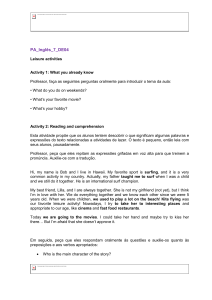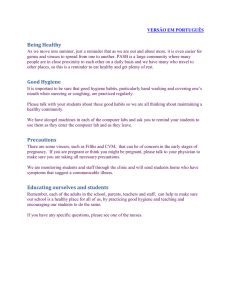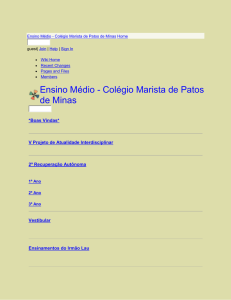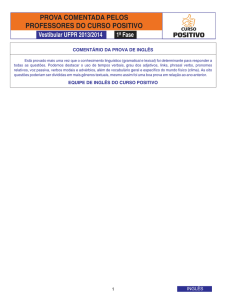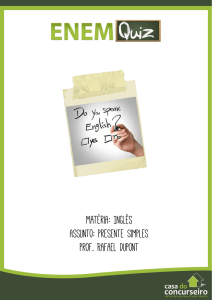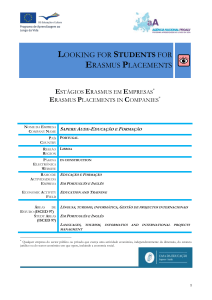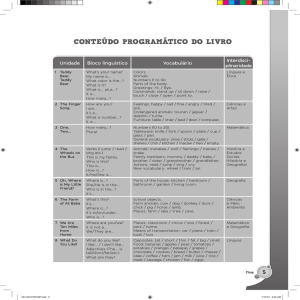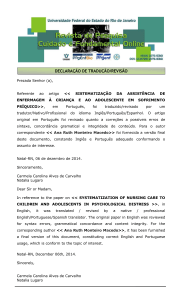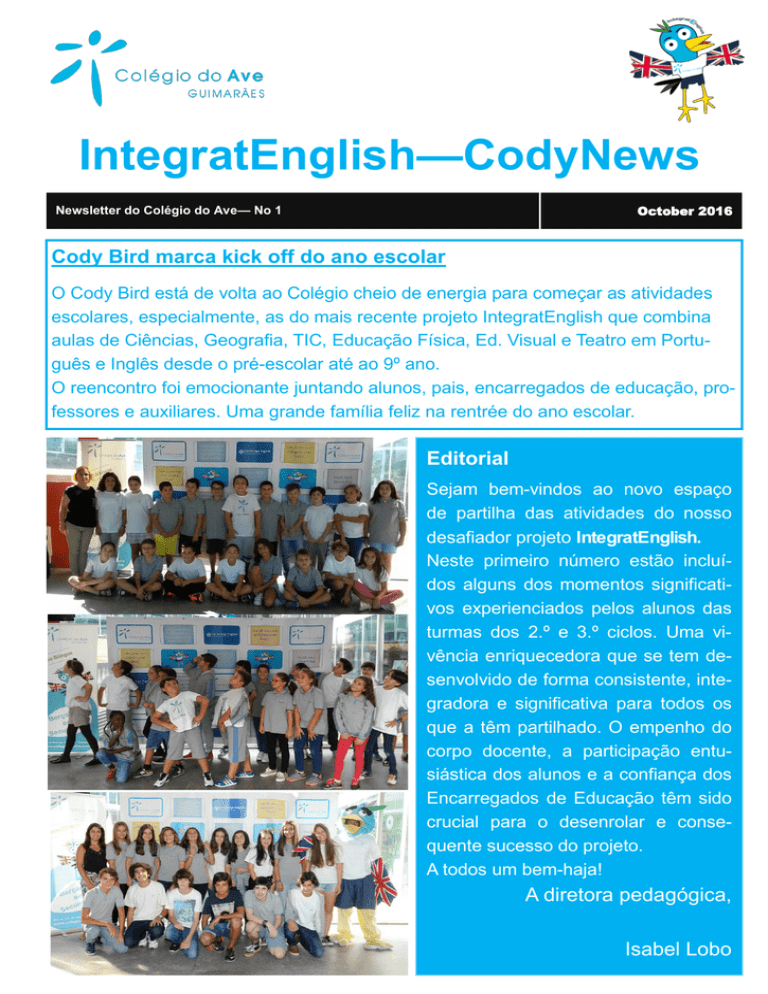
IntegratEnglish—CodyNews
October 2016
Newsletter do Colégio do Ave— No 1
Cody Bird marca kick off do ano escolar
O Cody Bird está de volta ao Colégio cheio de energia para começar as atividades
escolares, especialmente, as do mais recente projeto IntegratEnglish que combina
aulas de Ciências, Geografia, TIC, Educação Física, Ed. Visual e Teatro em Português e Inglês desde o pré-escolar até ao 9º ano.
O reencontro foi emocionante juntando alunos, pais, encarregados de educação, professores e auxiliares. Uma grande família feliz na rentrée do ano escolar.
Editorial
Sejam bem-vindos ao novo espaço
de partilha das atividades do nosso
desafiador projeto IntegratEnglish.
Neste primeiro número estão incluídos alguns dos momentos significativos experienciados pelos alunos das
turmas dos 2.º e 3.º ciclos. Uma vivência enriquecedora que se tem desenvolvido de forma consistente, integradora e significativa para todos os
que a têm partilhado. O empenho do
corpo docente, a participação entusiástica dos alunos e a confiança dos
Encarregados de Educação têm sido
crucial para o desenrolar e consequente sucesso do projeto.
A todos um bem-haja!
A diretora pedagógica,
Isabel Lobo
GEOGRAPHY
Cartography - It’s a science that studies, makes and
publishes maps.
No âmbito do projeto IntegratEnglish, os alunos do 7.º ano abordaram
em Inglês, na disciplina de Geografia, o conteúdo "Cartografia - ciência
que estuda, cria e publica mapas".
Representations of the Earth
The Globe
World map (Planisfério)
Maps (Base or theme)
Urban maps / urban plans
Sketch of the landscape (Esboço)
Route (Roteiro)
Orthophotomap
GEOGRAPHY
Topics
Cartography
Representations of the Earth
Advantages and disadvantages of
the globe
The importance of using maps
English speaking countries
Types of maps
Main Aims
Learning the advantages and disadvantages of using
the globe
Identifying the representations of the Earth
Building a globe
Identifying the different continents and oceans
Identifying the English speaking countries
Distinguishing between base maps and theme maps
Identifying the features of the maps
SCIENCE
The Cells — The basis of life
Na disciplina de Ciências Naturais, os alunos do 8.º ano tiveram
oportunidade de abordar o tema “As células — a base da vida” .
Main aims of the lesson
Understand the cell as a basic unit of the existing biodiversity on earth;
Identify and distinguish prokaryotic cells and eukaryotic cells ;
Name the main characteristics of animal and plant
cells;
Name the main characteristics of animal and plant
cells based on light microscope observation .
Topics
The cell
Prokaryotic cells
Eukaryotic cells
Animal cells
Plant cells
SCIENCE
We recycle—Reuse, reduce, recycle
Na disciplina de Ciências Naturais, os alunos do 9.º ano desenvolveram um trabalho de projeto intitulado “Value your waste” com os objetivos de distinguir os diversos tipos de
resíduos, resumir a importância da promoção da recolha, do tratamento e da
gestão sustentável de resíduos e de
planificar a realização de campanhas
de informação e de sensibilização sobre a gestão sustentável de resíduos.
ARTS
ANCIENT ORIGINS OF HALLOWEEN
Halloween’s origins date back to an ancient
Celtic festival. The Celts, who lived 2,000
years ago in the area that is now Ireland, the
United Kingdom and northern France, celebrated their new year on November 1.
This day marked the end of summer and the
harvest and the beginning of the dark, cold
winter, a time of year that was often associated with human death.
Celts believed that on the night before the
new year, 31st October, the boundary
between the worlds of the living and the dead became blurred and the ghosts of the dead returned to earth.
ARTS
Celebrating Halloween
No âmbito do projeto IntegratEnglish, os alunos do 2.º ciclo estão a
vivenciar na disciplina de
Educação Visual e Tecnológica, uma experiência cultural oriunda do
Reino Unido.
Jack O’Lantern
No âmbito do projeto
IntegratEnglish, os
alunos do 3º ciclo estão a explorar a lenda
irlandesa do temido
Jack O’Lantern, ilustrando alguns dos
seus momentos mais
tenebrosos.
ARTS
THE LEGEND OF “STINGY JACK”
People have been making jack-o’-lanterns
at Halloween for centuries. The practice originated
from an Irish myth about a man nicknamed “Stingy
Jack.” According to the story, Stingy Jack invited
the Devil to have a drink with him. True to his name,
Stingy Jack didn’t want to pay for his drink, so he
convinced the Devil to turn himself into a coin that
Jack could use to buy their drinks. Once the Devil
did so, Jack decided to keep the money and put it
into his pocket next to a silver cross, which prevented the Devil from changing back into his original
form. Jack eventually freed the Devil, under the
condition that he would not bother Jack for one year
and that, should Jack die, he would not claim his
soul. The next year, Jack again tricked the Devil
into climbing into a tree to pick a piece of fruit. While he was up in the tree, Jack carved a sign of the
cross into the tree’s bark so that the Devil could not
come down until the Devil promised Jack not to
bother him for ten more years.
Soon after, Jack died. As the legend goes, God
would not allow such an unsavory figure into heaven. The Devil, upset by the trick Jack had played
on him and keeping his word not to claim his soul,
would not allow Jack into hell. He sent Jack off into
the dark night with only a burning coal to light his
way. Jack put the coal into a carved-out turnip and
has been roaming the Earth with ever since. The
Irish began to refer to this ghostly figure as “Jack of
the Lantern,” and then, simply “Jack O’Lantern.”
In Ireland and Scotland, people began to make their
own versions of Jack’s lanterns by carving scary
faces into turnips or potatoes and placing them into
windows or near doors to frighten away Stingy Jack
and other wandering evil spirits. In England, large
beets are used. Immigrants from these countries
brought the jack o’lantern tradition with them when
they came to the United States. They soon found
that pumpkins, a fruit native to America, make perfect jack-o’-lanterns.
Have a spooky Halloween!
SPORTS
IntegratEnglish Sports — Badminton and Handball
Na disciplina de Educação Física, os alunos do 2.º ciclo abordaram
as modalidades Badminton e Andebol recorrendo aos vocabulários
geral e específico da Língua Inglesa.
Examples of some of the vocabulary used
Field or court
Skills
Goal Area
Running
Goal
Jumping
Baseline
Dodging
Sideline
Passing
Centerline
Dribbling
9,7,6,4 m line
Catching
Corner
Shooting
Holding
Intercepting
Pass and go
Rules
Defenders may not take, strike or grab the ball
out of the hands of de opponent
Three seconds
Three steps
Free throw
Penalty throw /penalty line
Players can’t use their lower legs and feet to stop
the ball
SPORTS
IntegratEnglish Sports — Badminton and Basketball
Na disciplina de Educação Física, os alunos do 3.º ciclo abordaram as
modalidades Badminton e Basquetebol recorrendo aos vocabulários
geral e específico da Língua Inglesa.
Specific Badminton vocabulary
Specific Basketball vocabulary
Shuttlecok, racket, net, grip, beat, court, team,
teammate, opponent, referee, rules, victory, defeat, exercise, punctuation, steps, score, simulate,
Below the waist, hit the birdie, service, head of the
racket, inside/outside, lands / touch floor, rally
scoring, points and sets, forehand, backhand and
rebound.
Ball, team, teammate, opponent, attacker, defender,
dribble, referee, violation, rules, victory, defeat,
pass, exercise, punctuation, reception, steps, score,
simulate, shot.
COMPUTER SCIENCE & THEATRE
Preparing Christmas
No âmbito do projeto IntegratEnglish, os alunos do 3.º ciclo estão a desenvolver na disciplina de
Oficina de Tecnologias a criação
de livros digitais de Natal em Inglês e a criar postais de Natal em
Inglês na disciplina de Tecnologias
de Informação e Comunicação.
“O julgamento do Pai
Natal”
No âmbito do projeto IntegratEnglish, os alunos do 8º
ano, juntamente com o professor de Teatro, estão a preparar a representação da peça de teatro “O julgamento
do Pai Natal”, incluindo no
texto algumas passagens em
Inglês.
Ladies and gentlemen, get
ready for this amazing
Christmas party!
Christmas carols
Oh, jingle bells, jingle bells
Jingle all the way
Oh, what fun it is to ride
In a one horse open sleigh
Jingle bells, jingle bells
Jingle all the way
Oh, what fun it is to ride
In a one horse open sleigh.
Coming up next...
CHEMISTRY
The Solar System
No âmbito do projeto IntegratEnglish, os alunos
do 7.º ano abordarão em
Inglês, na disciplina de Ciências Físico-Químicas, o
conteúdo "The Solar System".
Challenge
Let’s learn a bit more about the solar
system?
I don’t have atmosphere...
I don’t have any moons...
I have a solid surface that is covered with
craters...
Who am I?
SCIENCE
Coming up next...
Digestive system
No âmbito do projeto IntegratEnglish, os alunos do 6.º ano abordarão
em Inglês, na disciplina
de Ciências Naturais, o
conteúdo "Sistema digestivo”. Pretende-se que no
final das sessões, os alunos sejam capazes de
identificar e localizar os
órgãos constituintes do
sistema digestivo.
Rocks and Minerals
Quartz, Feldspar and Mica
No âmbito do projeto IntegratEnglish, os alunos do 5.º
ano abordarão em Inglês, na
disciplina de Ciências Naturais, o conteúdo "Rochas e
Minerais”. Pretende-se que no
final das sessões, os alunos
sejam capazes de distinguir a
sua tipologia e consigam identificar as suas propriedades
características e onde podem
ser aplicados.
Coming up next...
GEOGRAPHY
Globes and Mental maps
No âmbito do projeto IntegratEnglish, os alunos do 7.º ano continuarão
a abordar em Inglês, na disciplina de Geografia, o conteúdo "Terra—
Estudos e representações”. Pretende-se que no final das sessões, os
alunos sejam capazes de diferenciar as diversas representações do
mundo.
Age structure
population and
migration
No âmbito do projeto IntegratEnglish,
os alunos do 8º ano
continuarão a abordar em Inglês, na
disciplina de Geografia, os conteúdos
estrutura etária e
migração.
GEOGRAPHY
Trade and tourism
No âmbito do projeto
IntegratEnglish, os
alunos do 9.º ano
continuarão a abordar em Inglês, na disciplina de Geografia,
o conteúdo
"Comércio e Turismo”.
Colégio do Ave, SA.
Rua do Alto da Bandeira – Creixomil
4835-014 Guimarães
Telefone: 253 421 580/962 039 195
Fax: 253 421 589
E-mail: [email protected]
Site: www.colegiodoave.pt
Coming up next...


